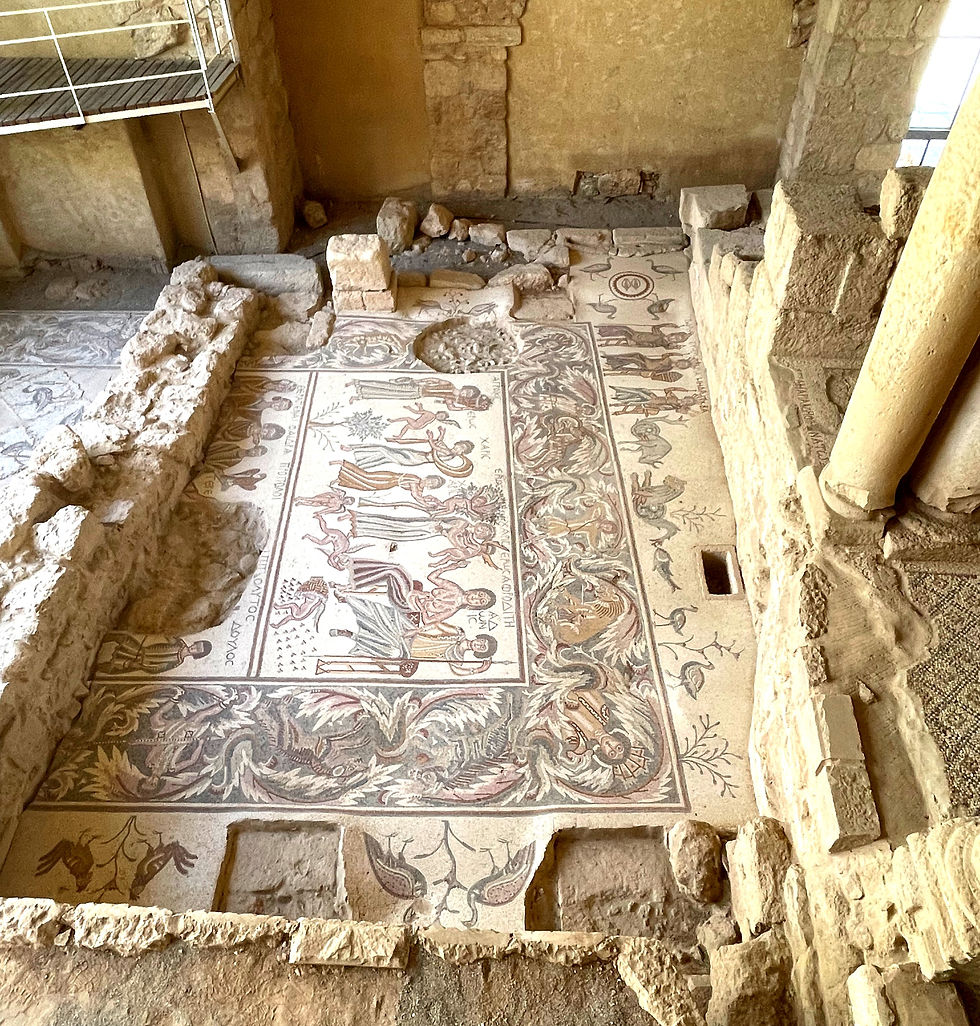Madaba, Jordan City of Mosaics
- ellen
- Oct 30, 2022
- 3 min read
Updated: 2 days ago

If like me you love mosaics, Madaba is a must-see when you visit Jordan. Located just 20 miles south of Amman, it's an easy half-day trip or a stopover as we made it on our way to Petra.
The Church of St. George
This impressive floor mosaic depicting the Holy Land was created in the mid 6th century CE in the early Byzantine church of St. George. It's the earliest map ever found of the holy land and specifically of Jerusalem. It originally measured 70 x 23 ft. and contained more than 2 million mosaic tiles. After centuries of deterioration, it's still impressive, but only about a quarter of it remains today.
This is a close-up of the Old City of Jerusalem which is very accurate according to historians.

After the mosaic's discovery in 1884, it was damaged by fires and the environment until 1965 when archeologists undertook careful renovation.

The church is small but lovely and there are more mosaics on the walls.
The mosaic of Christ being prepared for burial was almost identical to the one we saw in the Church of the Holy Sepulchre in the Old City of Jerusalem.

The little square in front of the church.

Hippolytus Hall
The Church of St. George isn't the only location that houses beautiful mosaics in Madaba. Next to the church is the Archeological Park, a relatively small and easily walkable area in which is located the Hippolytus Hall.

Originally part of a private villa from the 6th century CE, these mosaics were discovered in 1905 by the homeowner and more were discovered in 1982. They depict the myth of Hippolytus who was a sportsman and dedicated his life to hunting and chastity. In the end, he rejects advances from the goddess Aphrodite and eventually meets a tragic death after being thrown off his chariot.

The mosaics depicted many nature scenes and were incredibly well restored. Imagine living in a house with these floors!
Church of the Apostles
The third site we visited in Madaba was the Church of the Apostles, a short walk from the center of town. A mosaic inscription, now destroyed, indicated the name of the church and its completion date of 578. The church was discovered in 1902 and contains many beautiful and well restored mosaics on its floor.

This central medallion depicts a woman rising from the waves with sharks and other sea creatures surrounding her.


The face below represents a season, possibly summer.

More beautifully preserved mosaics from this church.
My son-in-law David and me.

The City of Madaba
Madaba is a lively city with a population of about 60,000, and when we visited it was busy with tourists, especially around the Church of St. George.

It was fun to walk from one site to another, taking in the local color.
A map of the three sites we visited.

➜ Top Tips
Madaba can be visited in an easy half-day trip from Amman or when traveling to or from Petra or other parts of southern Jordan such as we did.
None of the three sites we visited was included in the Jordan Pass, however the entrance fees were inexpensive. Both churches were 1 JD each and the Hippolytus Hall was 2 JD.
Despite the above, buy the Jordan Pass. It will pay for your visa upon arrival in Jordan and it will get you into many museums and other tourist attractions such as Petra. Read more about it here.
The Church of the Apostles is a five-minute walk to the edge of town, all downhill which means a pretty steep climb uphill when returning. We had hired a driver from Amman to Petra for the five of us (highly recommended) and our van was parked by the Church of St. George but if you have your own car, you can easily drive down to the Church of the Apostles.































Comments